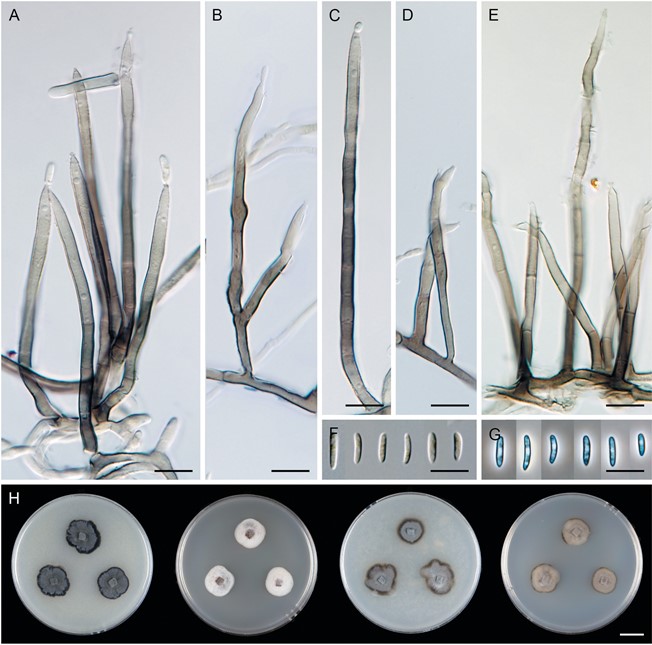Achrochaeta talbotii (S. Hughes, W.B. Kendr. & Shoemaker) Réblová & Hern.-Restr.
MycoBank number: MB 835574; Index Fungorum number: IF 835574; Facesoffungi number: FoF14542
Basionym: Chaetosphaeria talbotii S. Hughes, W.B. Kendr. & Shoemaker, N Z J Bot 6:364. 1968.
Description on MLA: Colonies effuse. Conidiophores 45–115 × 2–3.5 μm, up to 10-septate, macronematous, mononematous, unbranched, rarely simply branched, upright, straight or slightly flexuous, cylindrical, brown toward the base, pale brown to subhyaline toward the apex. Conidiogenous cells phialidic, 12.5–30 × 2.5–3.5 μm, tapering to 1–1.5 μm just below the collarette, cylindrical, subhyaline to hyaline, terminal, integrated, with a single apical opening or with up to four lateral openings formed by successive sympodial elongation. Collarettes 1–1.5 μm diam and 1–2 μm deep, narrowly funnel-shaped, hyaline. Conidia 6–9.5(–10) × 1.5–2.5 μm (mean ± SD = 8.0 ± 0.9 × 2.0 ± 0.2 μm), cylindrical- clavate, somewhat straight to slightly curved, obtuse at the apical end, gradually tapering toward the basal end, non- septate, nonsetulate, hyaline, smooth.
Culture characteristics: On CMA: colonies 13–14 mm diam after 28 d, circular, slightly convex, margin undulate, finely furrowed, velvety, dark gray with a black outer zone of submerged growth, reverse dark gray. On MLA: colonies 11–12 mm diam after 28 d, circular, convex, margin entire, sparsely velvety, finely furrowed, isabelline with irregular gray spots, reverse beige. On OA: colonies 11–14 mm diam after 28 d, circular, flat becoming slightly convex, margin weakly undulate, velvety, pale gray-brown, with a dark brown outer zone of submerged growth, reverse olivaceous brown. On PCA: colonies 10–12 mm diam after 28 d, circular, slightly convex, margin entire, velvety, finely furrowed, zonate, beige-gray, isabelline at the margin, with a dark olivaceous brown outer zone of submerged growth, reverse gray.
Specimen examined: NEW ZEALAND. CANTER- BURY: Selwyn District, Arthur’s Pass National Park, Kelly Shelter, Cockayane Nature Walk, 16 Mar 2003, on decaying wood of a branch, M. Réblová M.R. 2847/NZ 363 (PDD 81886). Culture ICMP 15161. GenBank: 28S = MT454495; ITS = MT454480.
Habitat and distribution: Saprobes on decaying wood and bark of Eucalyptus sp. and another unidentified host. The species is known from Australia and New Zealand (Hughes and Kendrick 1968; this study).
Notes: For description and illustration of the teleomorph and anamorph on the natural substrate, see Hughes and Kendrick (1968). The present isolate ICMP 15161 of A. talbotii was derived from conidia; the teleomorph was absent on the natural substrate. Our specimen matches well the protolog. It formed gray to dark brown, effuse colonies on the natural substrate. Conidiophores were up to 165 μm long and 3–4.5 μm wide above the base, crowded, irregularly bent, unbranched, dark brown toward the base, pale brown to subhyaline toward the apex, terminating into a mono- or polyphialide with up to three lateral openings. Some of the conidiophores appeared sterile, shorter, ending in a subhyaline, rounded apical cell. Phialides 26–32 × 2.5–3 μm tapering to 1.5 μm below the narrow, funnel-shaped collarette. Conidia were aggregated in hyaline, slimy droplets at the tips of the conidiogenous cells, 8–9 × (1.5–)2 μm, clavate to oblong-clavate, slightly curved, gradually tapering toward the base, hyaline, nonseptate, smooth.
Achrochaeta talbotii can be compared with several phenotypically similar species. They include D. clavulata and D. minutissima (Gams and Holubová-Jechová 1976; Holubová-Jechová 1984; Hernández-Gutiérrez and Mena- Portales 1996), not accepted in the genus in this study, and also Chloridium atanagildae (Holubová-Jechová and Mercado Sierra 1984) and Chl. codinaeoides (Pirozynski 1972). These species resemble Achrochaeta in the absence of setae, pigmented conidiophores and phialidic conidiogenous cells, and asymmetrical, usually clavate, hyaline, nonsetulate, nonseptate conidia. Dictyochaeta clavulata is distinguished from A. talbotii by longer (up to 340 μm vs. up to 220 μm fide Hughes and Kendrick 1968) conidiophores, polyphialides with lateral openings densely accumulated at the apex, and conidia abruptly tapered at the base (Gams and Holubová-Jechová 1976). Dictyochaeta minutissima and Chl. codinaeoides differ from A. talbotii by the lack of a defined collarette and semiendogenous conidia. Moreover, the conidiophores of D. minutissima are branched and arise from thick-walled, opaque, lobate basal cells (Hernández-Gutiérrez and Mena Portales 1996). Besides, Chl. codinaeoides differs from A. talbotii by two types of conidia, shorter and narrower (4–5 × 1–1.5 μm) clavate, and narrower (0.5–1 μm wide) falcate conidia (Pirozynski 1972). Chloridium atanagildae is well comparable to A. talbotii but differs by smaller (5–6 × 1.5–1.8 μm) conidia that are tapered to a pointed apical and basal ends.

Figure 14. Achrochaeta talbotii (ICMP 15161). A–E. Conidiophores. F, G. Conidia. A–D, F, G. In MLA culture. E. In PCA culture. H. Colonies on CMA, MLA, OA, and PCA after 28 d (from left to right). Bars: A–G = 10 μm; H = 1 cm.
